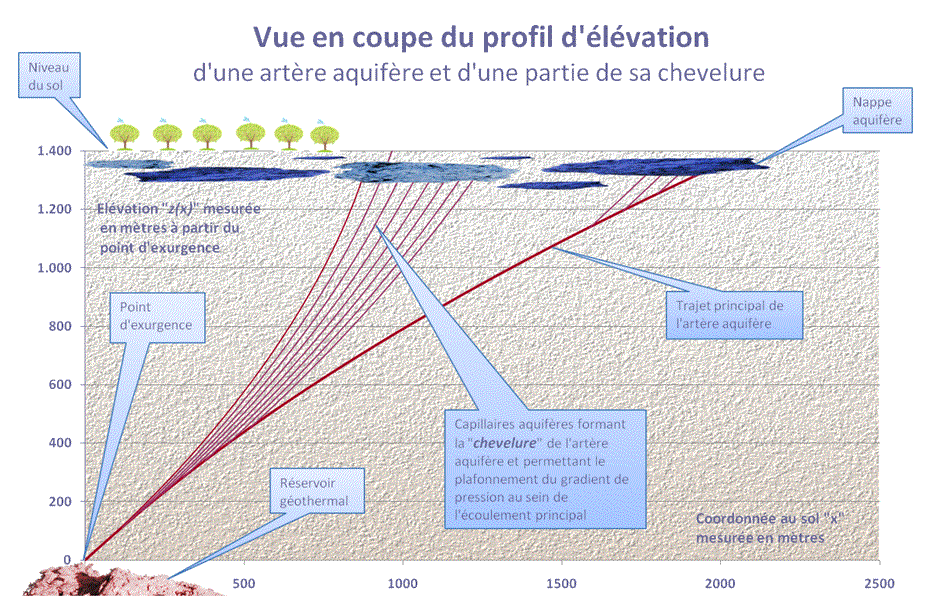Profile of rise in a water artery
A water artery rises starting from the exurgence point of a geothermal reservoir according to a trajectory which curves gradually downwards. This trajectory finishes quasi systematically in an aquifer. Hydrodynamics of the water artery the pleasing one to leak in a recurring way along its way before reaching the aquifer in which it flows. It gives birth thus, along its way, with a large number of water capillaries which constitute its “tail”.
The diagram below presents a cross-section of a standard profile of rise in a water artery, i.e. the theoretical way which a water artery in a vertical plan goes through. This graph is derived from a model angiometric developed by ANGIOO on the basis of angiogeological survey. The presence of various geological layers is not taken into account in this simplified model.
Profile of rise in a water artery and its tail
Determination of the profile of rise
The water arteries are formed at the exurgence point (of leakage) of a geothermal reservoir according to E mechanism of angiogeogenesis presented.
In Addition To the laws of the hydrodynamics, two other laws condition the flow within water vessels. The first of these laws is called the law of radial determination of the water flow. It is mainly this law which is with work during the angiogeogenesis and which was described within this framework. The second law, used to establish the profile of rise in a water vessel, is called the law of axial determination of the water flow. It is stated as follows:
Natural underground underground water flows maximize the hydraulic energy evacuated out of water reservoirs
By hydraulic energy, it is necessary to understand all shapes of energy of the fluid moving, except for thermal energies, chemical and atomic.
The water vessels formed by the mechanism of angiogeogenesis follow, starting from their point of formation a way in a vertical plan prescribes by this law.
Only one water artery is represented on the diagram above. Its hydrodynamics leads to the joint increase its rate of flow and its gradient of pressure along its way.
Influence hydrodynamics on the way of the water arteries in vertical plan
While going up towards surface, the water artery undergoes an increase in its gradient of pressure. This One exceeds its hydrodynamic confinement ceiling (i.e. the maximum gradient of pressure that this water artery can support before leaking -! for a water reservoir, it is the pressure which is determining, for a water vessel, it is the gradient of pressure which counts). The going beyond this hydrodynamic confinement ceiling results in the formation of a water capillary which brings back the gradient of pressure under the hydrodynamic confinement ceiling. A Little downstream, this situation of increase in the gradient of pressure again causes a going beyond this ceiling and conduit, same manner, with the formation of a new water capillary. This process of ramification continues in a recurring way thus. The flow of a water capillary is much lower (< 1 %) that of the main branch of the water artery.
This recurring mechanism of formation of water formations of capillaries contributes to the hydrodynamic stabilization of the flow within the water vessels.
This recurring formation of water capillaries causes incurvation to the bottom of the way of the water artery. In first and coarse approximation, the profile of rise in the main branch of a water artery is connected with an arc of cycloid. The slope of the way decreases gradually with the rise measured starting from the exurgence point. This incurvation to the bottom increases the chances that this way meets an aquifer and comes to flow there by thus increasing the pressure there. Almost all the water arteries end in an aquifer. When the water artery ends directly surfaces some, it produces thermal demonstrations such as hot sources, geysers, salses (also called mud volcanos) or sulfur springs (vapor emanations saturated with hydrogen sulfide).
The water capillaries are not subdivided. Their flow is too low to produce a “capillary of capillary”. Their trajectory is more vertical. It does not curve to the bottom, it is rectified. The water capillaries end in an aquifer close to surface. Even if they are also detectable by angiogeoscopy, the water capillaries are not the object of complete surveys.
The profile of rise in the water arteries and the water veins obeys the same laws, only the variables of state and the flow parameters differ from the one with the other.
On the ground, a water vessel does not remain in a vertical plan. The least irregularity of the subsoil deviates projection on the ground of its way. Such ways are illustrated in the presentation of their survey on the ground. This consideration does not influence the profile of rise as presented.
What such a model angiometric teaches us
The angiogeology balances between, on the one hand, measurements on the ground and, on the other hand, mathematical modeling and data processing of the underground water hydrodynamics: it adjusts its models with the readings of ground taken and it deduces from the models certain values that it cannot directly obtain within the framework of a survey.
What is essential to retain is that, more one exurgence point gives rise to a large number of water arteries and more those are long, more it will be interesting to exploit (any consideration relating to the chemical composition of the geological fluid excluded).
The exurgence point corresponds to the optimal collecting location of a water bearing site. To Provide to drill up to such a point thanks to the knowledge of its projection on the ground constitutes to Holy Grail it hydrogeological survey.
The models angiometric are exploitable thanks to the fact that the water vessels form a permanent structure, because they correspond to a hydrodynamic balance and that this hydrodynamic balance is stable.

